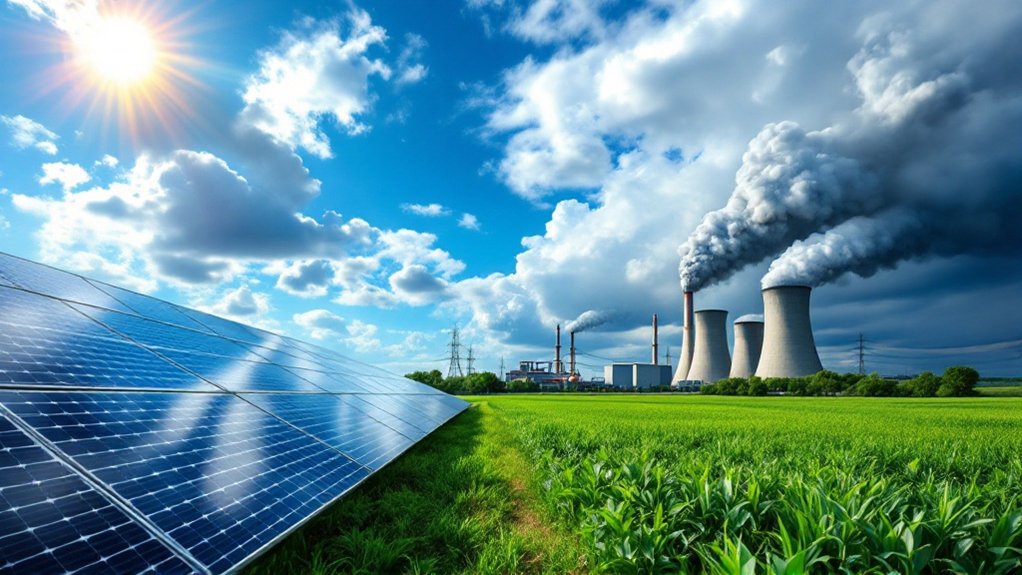
Solar Energy Technology Vs Traditional Energy Sources
The debate between solar energy technology and traditional energy sources highlights significant differences in sustainability and environmental impact. Solar energy offers a cleaner alternative, while traditional sources contribute to pollution and climate change. However, the initial costs of solar panels can be a barrier. As advancements continue, the dynamics of energy production may shift. What implications could these changes have for future energy consumption and policy?
Overview of Solar Energy Technology
Solar energy technology harnesses the sun’s radiant energy to produce electricity and heat. This process primarily involves photovoltaic cells, which convert sunlight directly into electricity, and solar thermal systems, which capture heat for various applications. The technology has advanced considerably, allowing for increased efficiency and reduced costs. Solar panels can be installed on rooftops, in solar farms, or integrated into building materials, offering flexibility in deployment. Energy storage solutions, such as batteries, further enhance solar energy’s viability by storing excess energy for later use. As a renewable energy source, solar energy contributes to energy independence and can reduce reliance on fossil fuels. Overall, solar energy technology presents a sustainable alternative in the quest for cleaner energy solutions. Furthermore, investments in renewable energy are expected to continue growing, driving further advancements in solar technology.
The Environmental Impact of Traditional Energy Sources
Traditional energy sources have significant environmental impacts, particularly regarding air pollution and water contamination. The combustion of fossil fuels releases harmful emissions that degrade air quality and contribute to public health issues. Additionally, extraction and processing methods can lead to serious risks of water contamination, affecting ecosystems and communities alike. The reliance on these sources ultimately undermines efforts toward environmental protection, which is crucial for a sustainable future.
Air Pollution Effects
A significant portion of global air pollution can be attributed to the combustion of fossil fuels, which releases a variety of harmful pollutants into the atmosphere. These pollutants include sulfur dioxide, nitrogen oxides, and particulate matter, which contribute to respiratory illnesses, cardiovascular diseases, and environmental degradation. The impact extends beyond human health; acid rain, resulting from these emissions, severely damages ecosystems, soil, and water sources. Additionally, greenhouse gases released during fossil fuel combustion exacerbate climate change, leading to further air quality deterioration. Urban areas, heavily reliant on traditional energy sources, often experience smog and reduced visibility, which can disrupt daily life. Shifting to cleaner energy alternatives is crucial in mitigating these detrimental air pollution effects and promoting a healthier environment.
Water Contamination Risks
The extraction and use of fossil fuels not only contribute to significant air pollution but also pose substantial risks to water resources. Contaminants from drilling operations, such as heavy metals and hydrocarbons, can leach into groundwater and surface water, resulting in hazardous conditions for aquatic ecosystems and human health. Spills during transportation and storage further exacerbate this issue, leading to widespread environmental damage. Hydraulic fracturing, or fracking, introduces chemicals that can taint drinking water supplies. Additionally, thermal pollution from power plants can disrupt local water temperatures, affecting fish populations and biodiversity. In contrast, solar energy systems generate electricity without depleting or polluting water resources, highlighting the environmental advantages of renewable energy technologies over traditional fossil fuel practices.
Economic Considerations: Costs and Investments
How do solar energy technologies compare financially to conventional energy sources? The initial investment for solar installations can be substantial, often requiring significant capital for equipment and installation. However, over time, solar energy systems typically lead to reduced energy costs and lower utility bills. In contrast, traditional energy sources, while often cheaper upfront, incur ongoing costs associated with fuel procurement and fluctuating market prices. Additionally, solar energy benefits from government incentives and tax credits, which can offset initial expenses. As technology advances, the cost of solar panels continues to decline, making solar increasingly competitive. Long-term financial analysis shows that investing in solar energy can yield substantial savings, especially in regions with abundant sunlight and favorable policies. Moreover, the integration of AI in healthcare is creating innovative solutions to optimize energy consumption in various sectors.
Efficiency and Energy Output Comparison
The comparison of efficiency and energy output between solar energy technology and traditional sources reveals significant differences. Solar panel efficiency rates can vary widely, impacting overall energy production, while factors such as energy output variability and the lifespan of solar panels further influence their effectiveness. Understanding these elements is essential for evaluating the long-term viability of solar energy solutions. Additionally, the concentration of power in the energy sector can affect the adoption of renewable technologies like solar energy.
Solar Panel Efficiency Rates
What factors contribute to the varying efficiency rates of solar panels compared to traditional energy sources? Solar panel efficiency is primarily influenced by the type of materials used, such as monocrystalline or polycrystalline silicon, which affect their energy conversion capabilities. Environmental conditions, including sunlight intensity and temperature, also play a significant role. In contrast, traditional energy sources like coal or natural gas typically maintain a stable efficiency level, often surpassing that of solar panels. However, advancements in solar technology, such as bifacial panels and improved photovoltaic cells, continue to enhance efficiency rates. Overall, while solar panels may currently have lower efficiency rates compared to traditional sources, ongoing innovations promise to bridge this gap in the near future.
Energy Output Variability
Although solar energy systems offer significant benefits, their energy output can be highly variable, influenced by factors such as weather conditions, time of day, and geographic location. Unlike traditional energy sources, which often provide a consistent output, solar energy production fluctuates based on sunlight availability. For example, cloudy days or nighttime drastically reduce energy generation, which can challenge reliance on solar systems for consistent power supply. Geographic location also plays a critical role; areas with more sunlight yield higher energy outputs compared to regions with frequent overcast skies. This variability necessitates energy storage solutions and supplementary energy sources to guarantee a stable power supply, highlighting a key difference between solar technology and conventional energy systems.
Lifespan and Durability
Energy output variability impacts not only the reliability of solar systems but also their overall lifespan and durability compared to traditional energy sources. Solar panels typically have a lifespan of 25 to 30 years, with manufacturers often guaranteeing at least 80% efficiency after 25 years. However, factors such as environmental conditions can affect their longevity. In contrast, traditional energy sources, such as fossil fuel plants, can operate for 30 to 50 years, but they require extensive maintenance and infrastructure that can degrade over time. Additionally, solar systems tend to have fewer moving parts, leading to lower wear and tear. Ultimately, while both energy sources have their durability challenges, solar technology may offer a more sustainable option over the long term.
Reliability and Energy Storage Solutions
While solar energy has made significant advancements, its reliability often hinges on effective energy storage solutions. These solutions are essential for addressing the intermittent nature of solar power, which can be affected by weather conditions and time of day. Current technologies, including lithium-ion batteries, pumped hydro storage, and emerging alternatives like solid-state batteries, play an important role in enhancing the reliability of solar energy systems. By storing excess energy generated during peak sunlight hours, these systems can provide a consistent power supply when sunlight is insufficient. Investment in energy storage infrastructure is crucial for the broader adoption of solar energy, ensuring it can compete effectively with traditional energy sources. Ultimately, robust energy storage solutions will enhance the reliability and efficiency of solar energy systems. Furthermore, integrating mindfulness practices into energy management can promote a more thoughtful approach to energy consumption and sustainability.
Land Use and Resource Requirements
The comparison of land use between solar energy technology and traditional energy sources reveals significant differences in space efficiency. While solar installations require substantial land areas, their impact on resource extraction is generally lower compared to fossil fuel operations. Understanding these factors is essential for evaluating the overall sustainability of each energy source.
Space Efficiency Comparison
Space efficiency is a critical factor in evaluating the viability of solar energy technology compared to traditional energy sources. Solar panels require markedly less land area to produce equivalent energy levels when compared to fossil fuel plants. For instance, solar farms can be installed on rooftops, parking lots, and other underutilized spaces, minimizing the impact on natural habitats. In contrast, traditional energy sources often necessitate extensive land use for extraction and infrastructure, leading to potential environmental degradation. In addition, solar technology’s modular nature allows for scalable installations, making it adaptable to urban areas where space is limited. This efficiency in space utilization highlights solar energy’s potential in addressing energy demands without compromising valuable land resources.
Resource Extraction Impact
Although solar energy technology requires certain materials for panel production, its overall resource extraction impact is considerably lower than that of traditional energy sources. The mining and drilling activities associated with fossil fuels result in significant land degradation, habitat destruction, and pollution. In contrast, solar energy relies primarily on abundant materials like silicon, which are less environmentally invasive to extract. Moreover, solar installations can be placed on rooftops and degraded lands, minimizing their footprint. The resource requirements for solar technology generally entail lower energy input for extraction and processing compared to the extensive operations needed for coal, oil, or natural gas. Consequently, solar energy presents a more sustainable option regarding land use and resource extraction.
Technological Advancements in Solar Energy
As innovations continue to emerge, the field of solar energy is witnessing remarkable technological advancements that enhance efficiency and affordability. Recent developments include the rise of bifacial solar panels, which capture sunlight on both sides, markedly increasing energy output. In addition, advancements in photovoltaic materials, such as perovskite solar cells, promise higher efficiency rates at lower production costs. Energy storage technologies, like advanced lithium-ion and solid-state batteries, are also improving, allowing for better management of solar energy supply and demand. Moreover, tracking systems that adjust panel angles to follow the sun are becoming more accessible, maximizing solar capture. Collectively, these innovations are driving the shift to cleaner energy sources, making solar power a more viable option for consumers and businesses alike.
Policy and Regulatory Frameworks
The landscape of solar energy is greatly influenced by policy and regulatory frameworks that shape its development and deployment. Governments play an important role by establishing incentives, tax credits, and subsidies aimed at promoting solar technology adoption. Regulatory bodies also implement standards and guidelines to guarantee safety and efficiency in solar installations. Additionally, net metering policies enable homeowners to receive credit for surplus energy generated, further encouraging solar investments. However, inconsistent regulations across regions can create barriers for developers and investors. Compliance with local, state, and federal regulations is fundamental for successful project execution. Overall, a supportive policy environment is essential for advancing solar energy and facilitating its integration into the broader energy market.
Public Perception and Adoption Rates
How does public perception influence the adoption rates of solar energy? Public perception plays an essential role in the acceptance and integration of solar energy technologies. Positive perceptions, often shaped by awareness of environmental benefits and cost savings, can notably boost adoption rates. Conversely, misconceptions about solar energy—such as high costs or inefficiency—can hinder its acceptance. Social influence, media coverage, and community initiatives also impact public attitudes, with supportive narratives fostering a more favorable view. Additionally, perceived reliability and aesthetic concerns can either promote or deter installation decisions. As individuals and communities increasingly recognize solar energy’s potential, adoption rates are likely to rise, reflecting a collective shift toward sustainable energy solutions.
Future Trends in Energy Production and Consumption
While advancements in technology continue to reshape the energy landscape, future trends in energy production and consumption point toward a significant shift toward renewable sources, with solar energy leading the charge. Analysts predict an increasing reliance on decentralized energy systems, enabling consumers to generate their own electricity. Innovations in energy storage technology, such as advanced batteries, will enhance the viability of solar energy by addressing intermittency issues. Additionally, electric vehicles are expected to integrate further with renewable grids, creating a more sustainable energy ecosystem. Governments and corporations are likely to invest more in green energy infrastructure, driven by climate goals and societal demand for cleaner energy. Consequently, traditional fossil fuel sources may gradually decline, reshaping global energy dynamics.
Frequently Asked Questions
How Does Solar Energy Technology Impact Job Creation in the Energy Sector?
The impact of solar energy technology on job creation in the energy sector is significant, as it fosters new employment opportunities through manufacturing, installation, maintenance, and innovation, ultimately contributing to economic growth and workforce development.
What Are the Safety Concerns Associated With Solar Panels?
Safety concerns associated with solar panels include risks of electrical hazards, structural integrity under extreme weather, and potential chemical exposure during manufacturing and disposal. Proper installation and maintenance are essential to mitigate these risks effectively.
How Do Solar Panel Installations Affect Property Values?
The impact of solar panel installations on property values can vary greatly. Many studies indicate that properties with solar panels often see increased value, appealing to environmentally conscious buyers and those seeking lower energy costs.
Can Solar Energy Be Used in Off-Grid Applications Effectively?
The effectiveness of solar energy in off-grid applications has been widely recognized. Many rural and remote areas successfully utilize solar systems, providing reliable power for homes, businesses, and essential services without dependence on traditional energy infrastructure.
What Is the Lifespan of Solar Panels Compared to Traditional Energy Sources?
The lifespan of solar panels typically ranges from 25 to 30 years, while traditional energy sources often have variable lifespans depending on the infrastructure. This longevity contributes to solar energy’s growing appeal in sustainable energy solutions.
Conclusion
In summary, solar energy technology presents a compelling alternative to traditional energy sources, offering significant environmental benefits and long-term economic savings. As advancements in efficiency and energy storage continue to evolve, solar energy is becoming increasingly reliable and accessible. While initial investments may be substantial, government incentives and a growing public awareness of climate issues are driving adoption rates upward. The future of energy production and consumption is likely to favor sustainable solutions, positioning solar energy at the forefront.



